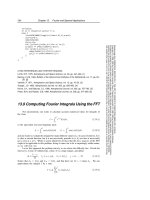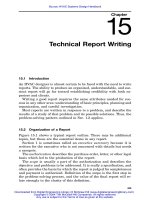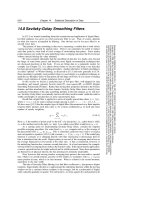Tài liệu Fourier and Spectral Applications part 4 pptx
Bạn đang xem bản rút gọn của tài liệu. Xem và tải ngay bản đầy đủ của tài liệu tại đây (70.75 KB, 3 trang )
13.3 Optimal (Wiener) Filtering with the FFT
547
Sample page from NUMERICAL RECIPES IN C: THE ART OF SCIENTIFIC COMPUTING (ISBN 0-521-43108-5)
Copyright (C) 1988-1992 by Cambridge University Press.Programs Copyright (C) 1988-1992 by Numerical Recipes Software.
Permission is granted for internet users to make one paper copy for their own personal use. Further reproduction, or any copying of machine-
readable files (including this one) to any servercomputer, is strictly prohibited. To order Numerical Recipes books,diskettes, or CDROMs
visit website or call 1-800-872-7423 (North America only),or send email to (outside North America).
13.3 Optimal (Wiener) Filtering with the FFT
There are a number of other tasks in numerical processing that are routinely
handled with Fourier techniques. One of these is filtering for the removal of noise
from a “corrupted” signal. The particular situationwe consider is this: There issome
underlying, uncorrupted signal u(t) that we want to measure. The measurement
process is imperfect, however, and what comes out of our measurement device is a
corrupted signal c(t). The signal c(t) may be less than perfect in either or both of
two respects. First, the apparatus may not have a perfect “delta-function” response,
so that the true signal u(t) is convolved with (smeared out by) some known response
function r(t) to give a smeared signal s(t),
s(t)=
∞
−∞
r(t − τ)u(τ) dτ or S(f)=R(f)U(f)(13.3.1)
where S, R, U are the Fourier transforms of s, r, u, respectively. Second, the
measured signal c(t) may contain an additional component of noise n(t),
c(t)=s(t)+n(t)(13.3.2)
We already know how to deconvolve the effects of the response function r in
the absence of any noise (§13.1); we just divide C(f) by R(f) to get a deconvolved
signal. We now want to treat the analogous problem when noise is present. Our
task is to find the optimal filter, φ(t) or Φ(f), which, when applied to the measured
signal c(t) or C(f), and then deconvolved by r(t) or R(f), produces a signal u(t)
or
U(f) that is as close as possible to the uncorrupted signal u(t) or U (f).Inother
words we will estimate the true signal U by
U(f)=
C(f)Φ(f)
R(f)
(13.3.3)
In what sense is
U to be close to U? We ask that they be close in the
least-square sense
∞
−∞
|u(t) − u(t)|
2
dt =
∞
−∞
U(f) − U(f)
2
df is minimized. (13.3.4)
Substitutingequations (13.3.3) and (13.3.2), the right-hand side of (13.3.4) becomes
∞
−∞
[S(f)+N(f)]Φ(f)
R(f)
−
S(f)
R(f)
2
df
=
∞
−∞
|R(f)|
−2
|S(f)|
2
|1 − Φ(f)|
2
+ |N(f)|
2
|Φ(f)|
2
df
( 13.3.5)
The signal S and the noise N are uncorrelated, so their cross product, when
integrated over frequency f, gave zero. (This is practically the definition of what we
mean by noise!) Obviously (13.3.5) will be a minimum if and only if the integrand
548
Chapter 13. Fourier and Spectral Applications
Sample page from NUMERICAL RECIPES IN C: THE ART OF SCIENTIFIC COMPUTING (ISBN 0-521-43108-5)
Copyright (C) 1988-1992 by Cambridge University Press.Programs Copyright (C) 1988-1992 by Numerical Recipes Software.
Permission is granted for internet users to make one paper copy for their own personal use. Further reproduction, or any copying of machine-
readable files (including this one) to any servercomputer, is strictly prohibited. To order Numerical Recipes books,diskettes, or CDROMs
visit website or call 1-800-872-7423 (North America only),or send email to (outside North America).
is minimized with respect to Φ(f) at every value of f. Let us search for such a
solution where Φ(f) is a real function. Differentiating with respect to Φ, and setting
the result equal to zero gives
Φ(f)=
|S(f)|
2
|S(f)|
2
+|N(f)|
2
(13.3.6)
This is the formula for the optimal filter Φ(f).
Notice that equation (13.3.6) involves S, the smeared signal, and N, the noise.
The two of these add up to be C, the measured signal. Equation (13.3.6) does not
contain U, the“true” signal. This makes for an importantsimplification: The optimal
filter can be determined independently of the determination of the deconvolution
function that relates S and U.
To determine the optimal filter from equation (13.3.6) we need some way
of separately estimating |S|
2
and |N|
2
. There is no way to do this from the
measured signal C alone without some other information, or some assumption or
guess. Luckily, the extra information is often easy to obtain. For example, we
can sample a long stretch of data c(t) and plot its power spectral density using
equations (12.0.14), (12.1.8), and (12.1.5). This quantity is proportional to the sum
|S|
2
+ |N|
2
,sowehave
|S(f)|
2
+|N(f)|
2
≈P
c
(f)=|C(f)|
2
0≤f<f
c
(13.3.7)
(More sophisticated methods of estimating the power spectral density will be
discussed in §13.4 and §13.7, but theestimation above is almost always good enough
for the optimal filter problem.) The resulting plot (see Figure 13.3.1) will often
immediately show the spectral signature of a signal sticking up above a continuous
noise spectrum. The noise spectrum may be flat, or tilted, or smoothly varying; it
doesn’t matter, as long as we can guess a reasonable hypothesis as to what it is.
Draw a smooth curve through the noise spectrum, extrapolating it into the region
dominated by the signal as well. Now draw a smooth curve through the signal plus
noise power. The difference between these two curves is your smooth “model” of
the signal power. The quotient of your model of signal power to your model of
signal plus noise power is the optimal filter Φ(f). [Extend it to negative values of f
by the formula Φ(−f)=Φ(f).] Notice that Φ(f) will be close to unity where the
noise is negligible, and close to zero where the noise is dominant. That is how it
does its job! The intermediate dependence given by equation (13.3.6) just turns out
to be the optimal way of going in between these two extremes.
Because the optimal filter results from a minimization problem, the quality of
the results obtained by optimal filtering differs from the true optimum by an amount
thatis second order in theprecision to which the optimalfilteris determined. In other
words, even a fairly crudely determined optimal filter (sloppy, say, at the 10 percent
level) can give excellent results when it is applied to data. That is why the separation
of the measured signal C into signal and noise components S and N can usefully be
done “by eye” from a crude plot of power spectral density. All of this may give you
thoughts about iterating the procedure we have just described. For example, after
designing a filter with response Φ(f) and using it to make a respectable guess at the
signal
U(f)=Φ(f)C(f)/R(f), you might turn about and regard
U(f) as a fresh
13.4 Power Spectrum Estimation Using the FFT
549
Sample page from NUMERICAL RECIPES IN C: THE ART OF SCIENTIFIC COMPUTING (ISBN 0-521-43108-5)
Copyright (C) 1988-1992 by Cambridge University Press.Programs Copyright (C) 1988-1992 by Numerical Recipes Software.
Permission is granted for internet users to make one paper copy for their own personal use. Further reproduction, or any copying of machine-
readable files (including this one) to any servercomputer, is strictly prohibited. To order Numerical Recipes books,diskettes, or CDROMs
visit website or call 1-800-872-7423 (North America only),or send email to (outside North America).
S
2
(deduced)
N
2
(extrapolated)
C
2
(measured)
log scale
f
Figure 13.3.1. Optimal (Wiener) filtering. The power spectrum of signal plus noise shows a signal peak
added to a noise tail. The tail is extrapolated back into the signal region as a “noise model.” Subtracting
gives the “signal model.” The models need not be accurate for the method to be useful. A simple
algebraic combination of the models gives the optimal filter (see text).
new signal which you could improve even further with the same filtering technique.
Don’t waste your time on this line of thought. The scheme converges to a signal of
S(f)=0. Converging iterative methods do exist; this just isn’t one of them.
You can use the routine four1 (§12.2) or realft (§12.3) to FFT your data
when you are constructing an optimal filter. To apply the filter to your data, you
can use the methods described in §13.1. The specific routine convlv is not needed
for optimal filtering, since your filter is constructed in the frequency domain to
begin with. If you are also deconvolving your data with a known response function,
however, you can modify convlv to multiply by your optimal filter just before it
takes the inverse Fourier transform.
CITED REFERENCES AND FURTHER READING:
Rabiner, L.R., and Gold, B. 1975,
Theory and Application of Digital Signal Processing
(Englewood
Cliffs, NJ: Prentice-Hall).
Nussbaumer, H.J. 1982,
Fast Fourier Transform and Convolution Algorithms
(New York: Springer-
Verlag).
Elliott, D.F., and Rao, K.R. 1982,
Fast Transforms: Algorithms, Analyses, Applications
(New
York: Academic Press).
13.4 Power Spectrum Estimation Using the FFT
Intheprevioussection we “informally”estimated thepowerspectral densityofa
functionc(t) by takingthemodulus-squaredofthediscrete Fouriertransformofsome









